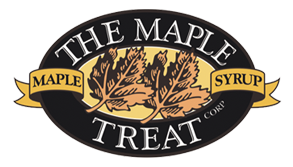UNIQUE INGREDIENTS
We use only natural ingredients with no artificial additives and to achieve the right sweetness we replaced fructose with sugar. Although we will keep the complete secret recipe to ourselves, we would like to offer a few facts about the two main ingredients we use in our special drink.
MAPLE SYRUP
The Legend of Nokomis (the earth)
A native legend says that maple syrup was discovered by Nokomis (the Earth), grandmother of Manabush, a hero of numerous First Nations’ stories. It was Nokomis who first made a hole in the trunk of the maple tree and gathered its sap. Manabush, noticing that this sap was already sweet enough to be consumed, sought out Nokomis and told her:
“Grandmother, it’s not good thing that the trees produce sugar so easily. If men can collect sugar without effort, they will become lazy. We must make them work. Before tasting this exquisite syrup, it would be better for men to be forced to cut wood and stay up all night to watch the syrup cook.”
Manabush said no more, but fearing that Nokomis would ignore his concerns and do nothing to prevent man from becoming lazy, he climbed high into a maple tree with a bucketful of water and poured it right into the trunk, thus diluting the sugar that was in the tree.
Even though we don’t know for sure if it was Manabush who determined the sugar content in maple sap or if the story was created to justify the hard work involved in the production of maple syrup, the fact remains that in order to get a great syrup, it’s not enough to just tap the tree and wait for the final product to emerge.
It takes approximately 40 liters of maple sap to make 1 liter of maple syrup. The maple sap is collected in either buckets or by way of a pipeline that brings sap from the tree to the processing area. The sap, which comes out of the tree with a sugar content of approximately 2%, is boiled until it reaches between 66% and 67.5% sugar content.
Maple syrup is a product unlike any other because its flavor and color vary throughout the season. Over a six week period, from the first major thaw of the Spring until the leaf buds burst, at which point the tree fluids begin to carry substances that give the syrup a harsh flavor, the taps remove around 10% of a tree’s sugar stores, in an average of 20-60 liters per tree.
As the season progresses, maple syrup’s fructose and glucose levels rise, while its sucrose levels drop slightly. These transformations in the maple water’s composition cause a change in the color and the taste of the maple syrup. The sap contains around 3% sucrose at the beginning of the season, half that at the end; so late-season sap must be boiled longer and is therefore darker and stronger-flavored.At the beginning of the season, the syrup is generally clear and the taste slightly sweet, as the season progresses, the syrup becomes darker and more caramelized. Canadian classification is using light transparency in the syrup as a determinant of the grade with # 1 for the lightest colors and # 3 for the dark ones.


We would like to thank the The Maple Treat from Quebec for supplying us with a high quality maple syrup.
WHISKY
Canadian whisky was born about a hundred years after the first pioneers settled in the land. Two centuries ago, Canadian flour millers began making whisky from their excess wheat. This was when wheat was the predominant grain for Canada’s pioneers. Along the way, someone decided to spice up their whisky by adding a small amount of rye grain to it and a distinctly Canadian whisky style was born.
Since rye releases stronger and spicier essences, this new whisky packed more flavour than common wheat whisky and almost everyone preferred it. Customers started demanding “rye” – essentially a wheat whisky with a small amount of rye grain added. Eventually, the word “rye” entered the Canadian lexicon as a synonym for whisky.
Gradually barley and corn were added to the spectrum of grains used in whiskey production and now rye is not even a necessary component in Canadian whisky. However, the terms “Canadian Whisky”, “Rye Whisky”, and “Canadian Rye Whisky” are legally indistinguishable in Canada and do not require any specific grain in their production. In order to be called Canadian whiskies, according to Canadian law they must be produced and aged in Canada, be distilled from a fermented mash of cereal grain, be aged in wood barrels with a capacity limit of 700 litres for not less than three years, and “possess the aroma, taste and character generally attributed to Canadian whisky”
Unlike in the U.S. where the “straight” whisky must be aged in brand new charred oak barrels, in Canada “rye” whisky is aged in a mixture of barrels that have already been used one or more times, as well as in new ones. Re-used barrels bring additional flavours to the whisky that are not detectable in whisky that has been aged in new oak. Some of these flavours taste like rye. And because the oak flavours are more subtle overall in re-used barrels, it takes a relatively smaller amount of rye grain to get a great surge of rye flavour. That’s may be why Canadian Whisky is perceived as more subtle, light-bodied, versatile and very mixable.
